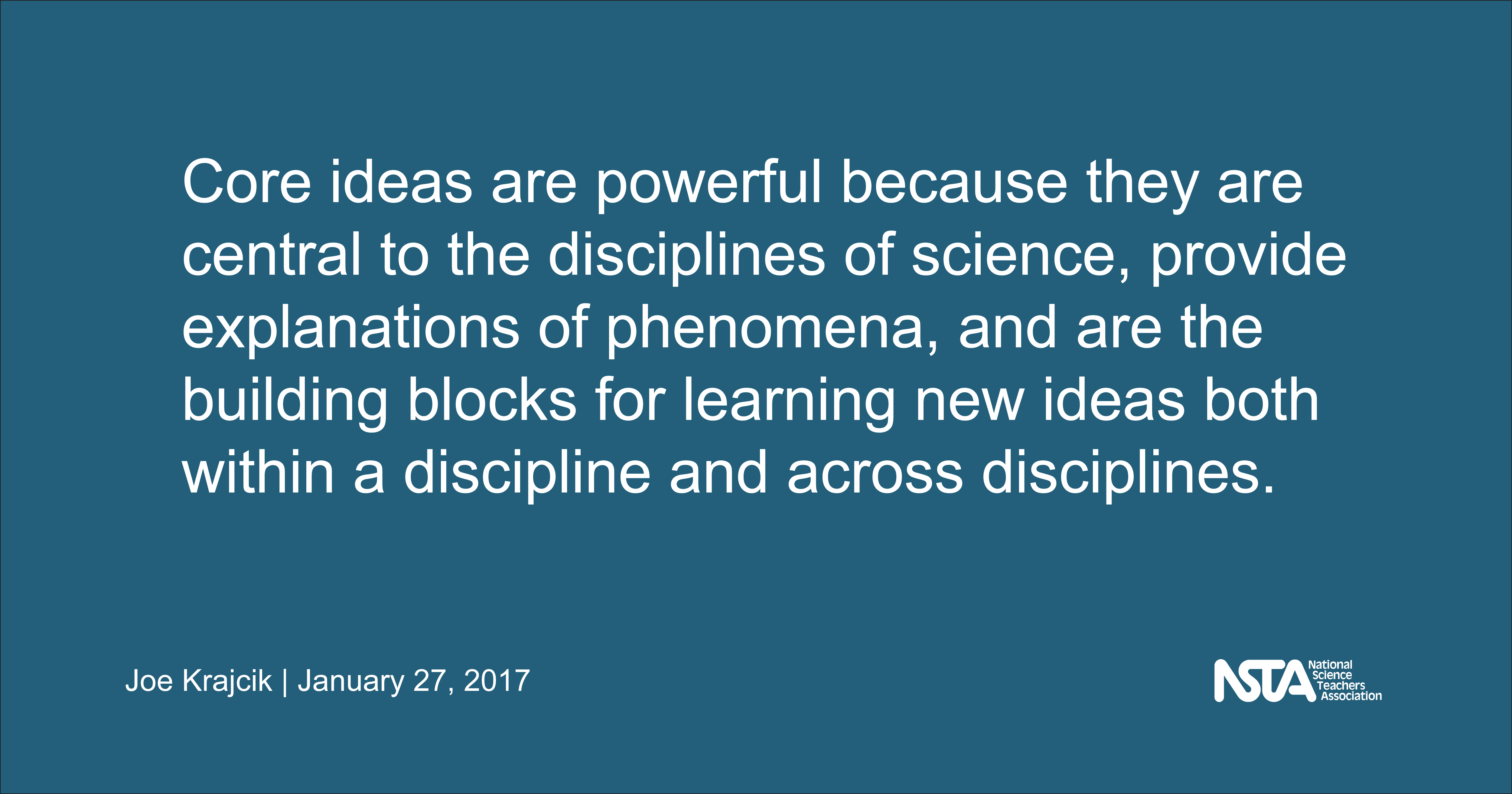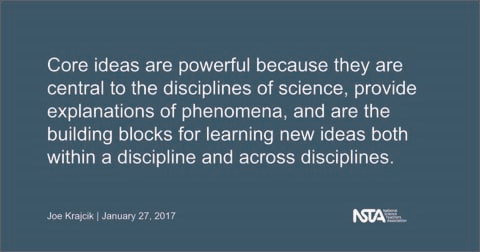What’s So Special about Disciplinary Core Ideas (Part 2)
By Joe Krajcik
Posted on 2017-01-27
DCIs provide explanations for a variety of phenomena
Last month I talked about how disciplinary core ideas (DCIs) form a conceptual framework. Now, I’d like to explore the idea that DCIs provide explanations for a variety of phenomena. Phenomena are reoccurring events that occur in the world. That an object falls to the lower point is a phenomenon. This is an everyday occurrence. Phenomena do not need to be phenomenal but they could be. Babies are born all the time. Birth is a phenomenon, but it is also phenomenal.
Disciplinary core ideas are central to the disciplines of science, provide explanations of phenomena, and are the building blocks for learning within and across disciplines (Stevens, Sutherland, & Krajcik, 2009). In many respects, DCIs are conceptual tools that empower learners to make sense of the world around them. As students use these conceptual tools, the ideas become more connected. While disciplinary core ideas are essential in explaining phenomena within a discipline, they are also essential in explaining phenomena across disciplines. Take for instance the idea of energy. Students can certainly use the idea of energy transfer to track the energy changes when various objects collide with one another. Yet, the concept of energy transfer is also critical in understanding photosynthesis and respiration. By focusing on a few powerful ideas, students learn the connections between ideas so that they can apply their understanding to explain situations that they have not yet encountered. I often refer to this type of connected knowledge as integrated understanding (Fortus & Krajcik, 2011). Supporting students in developing integrated understanding is critical as it allows learners to solve real-world problems, make sense of phenomena, and learn more. Perhaps the idea of learning more is one of most critical aspects—as we use the core ideas (along with practices and crosscutting concepts) the core ideas become richer and more connected.
If you think of a discipline in which you have the most expertise, you can imagine the disciplinary core ideas for that area as they form the network of understanding that allow you to explain phenomena. Close your eyes and think of an important phenomenon in your field. What ideas and what connections among those ideas do you see that explain that phenomenon? The ideas that you see and connections among them are likely core ideas. For example, individuals who have a background in chemistry might think of reacting various substances to form a new substance with different properties (phenomena) and ideas related to the particle nature of matter and energy (DCIs) to make sense of it. Individuals with backgrounds in physics might think of why a person gets a shock after walking on a rug and then touching a metal door knob (phenomena) and use ideas related to electrical interactions (DCIs) to makes sense of the experience; those with backgrounds in biology might think of the diversity of life that exists on earth (phenomena) and ideas related to natural selection (DCIs) to explain them. Individuals with a background in earth science might envision how earth structures are formed (phenomena) and ideas related to plate tectonics (DCIs) to help explain those structures.
 Core ideas are powerful because they are central to the disciplines of science, provide explanations of phenomena, and are the building blocks for learning new ideas both within a discipline and across disciplines (Stevens, Sutherland, & Krajcik, 2009). For example, electrical interactions (PS2) that occur at the molecular level can explain a variety of phenomena. One phenomenon the DCI helps explain is why water boils at the high temperature of 100O C, yet carbon dioxide boils at – 56 O C. Interestingly, carbon dioxide is a much more massive molecule (44 g/mole) than water (18 gram/mole). What causes water to stick together so much more than CO2? Based on its mass, one might suspect that water should boil at a much lower temperature than carbon dioxide. Using the ideas from the DCI can explain this rather strange case. Because of the strong electrical interactions that exist between water molecules and the relative weak electrical interactions that exist among carbon dioxide molecules, water boils at a much higher temperature. The strong electrical interactions that form among water molecules help to explain other diverse phenomena such as why so much energy is given off in a hurricane (i.e., gaseous water condensing to liquid water) and why proteins fold together the way they do. Explaining a diversity of phenomena is what makes DCIs so powerful.
Core ideas are powerful because they are central to the disciplines of science, provide explanations of phenomena, and are the building blocks for learning new ideas both within a discipline and across disciplines (Stevens, Sutherland, & Krajcik, 2009). For example, electrical interactions (PS2) that occur at the molecular level can explain a variety of phenomena. One phenomenon the DCI helps explain is why water boils at the high temperature of 100O C, yet carbon dioxide boils at – 56 O C. Interestingly, carbon dioxide is a much more massive molecule (44 g/mole) than water (18 gram/mole). What causes water to stick together so much more than CO2? Based on its mass, one might suspect that water should boil at a much lower temperature than carbon dioxide. Using the ideas from the DCI can explain this rather strange case. Because of the strong electrical interactions that exist between water molecules and the relative weak electrical interactions that exist among carbon dioxide molecules, water boils at a much higher temperature. The strong electrical interactions that form among water molecules help to explain other diverse phenomena such as why so much energy is given off in a hurricane (i.e., gaseous water condensing to liquid water) and why proteins fold together the way they do. Explaining a diversity of phenomena is what makes DCIs so powerful.
Let’s take a look at another powerful DCI; gene and environmental interactions. Often students believe that genes alone determine our physical characteristics. While it is true that our genes help determine who we are, the environment also plays an important role. For example, an individual might be prone to type 2 diabetes, but diet and exercise can certainly control the onset of this disease. Bottom line—the environment can do a lot to shape who and what we become. In Disciplinary Core Ideas: Reshaping Teaching and Learning (Duncan, Krajcik and Ravit, 2016) various chapters expand on the meaning of the disciplinary core ideas and their components.
In the next blog, I’ll explore how DCI’s develop over time.
I would love to hear your ideas, questions, and feedback on this blog. Tweet me at @krajcikjoe or email krajcik@msu.edu. If you want to learn more about the disciplinary core ideas take a look at our new book just published by NSTA Press; Disciplinary Core Ideas: Reshaping Teaching and Learning, edited by myself as well as Ravit Duncan, and Ann Rivet.
_____________________________________________________
Editor’s note: This blog is the second in a series of three by Joe Krajcik that explore the NGSS disciplinary core ideas. Click here to read the third and final installment in the series.
Joe Krajcik (Krajcik@msu.edu) is a professor of science education at Michigan State University and director of the Institute for Collaborative Research for Education, Assessment, and Teaching Environments for Science, Technology and Engineering and Mathematics (CREATE for STEM). He served as Design Team Lead for both the Framework and the NGSS.
References
Duncan, R., Krajcik, J., Ravit, A. Editors (authorship is alphabetical) (2016). Disciplinary Core Ideas: Reshaping Teaching and Learning. Arlington, VA: National Science Teachers Association Press.
Fortus, D. & Krajcik, J. (2011). Curriculum Coherence and Learning Progressions. Fraser, B. J., Tobin, K. G., & McRobbie, C. J. (Eds). The International Handbook of Research in Science Education (second edition). Dordrecht: Springer.
Stevens, S., Sutherland, L., & Krajcik, J.S., (2009). The Big Ideas of Nanoscale Science and Engineering. Arlington, VA: National Science Teachers Association Press.
The mission of NSTA is to promote excellence and innovation in science teaching and learning for all.
Future NSTA Conferences
2017 National Conference
STEM Forum & Expo
Follow NSTA
Disclaimer: The views expressed in this blog post are those of the author(s) and do not necessarily reflect the official position of the National Science Teaching Association (NSTA).




